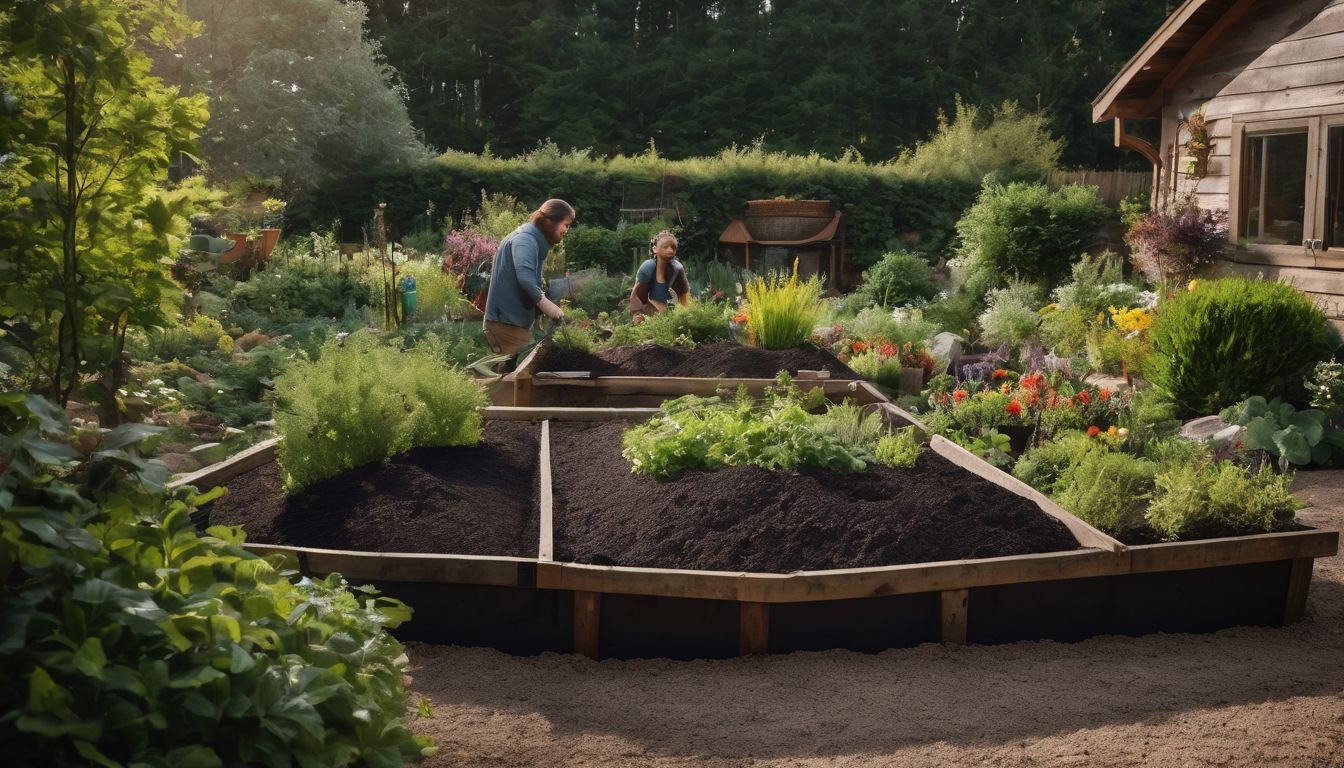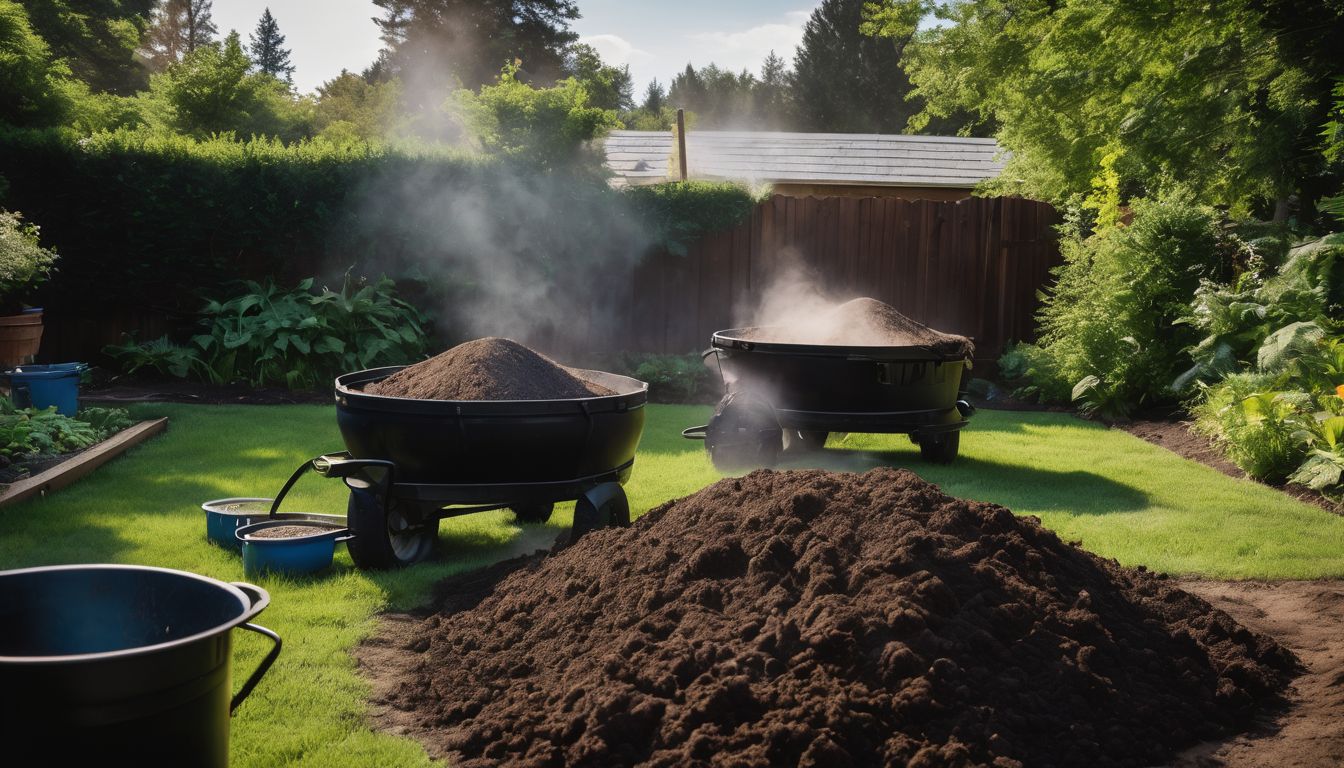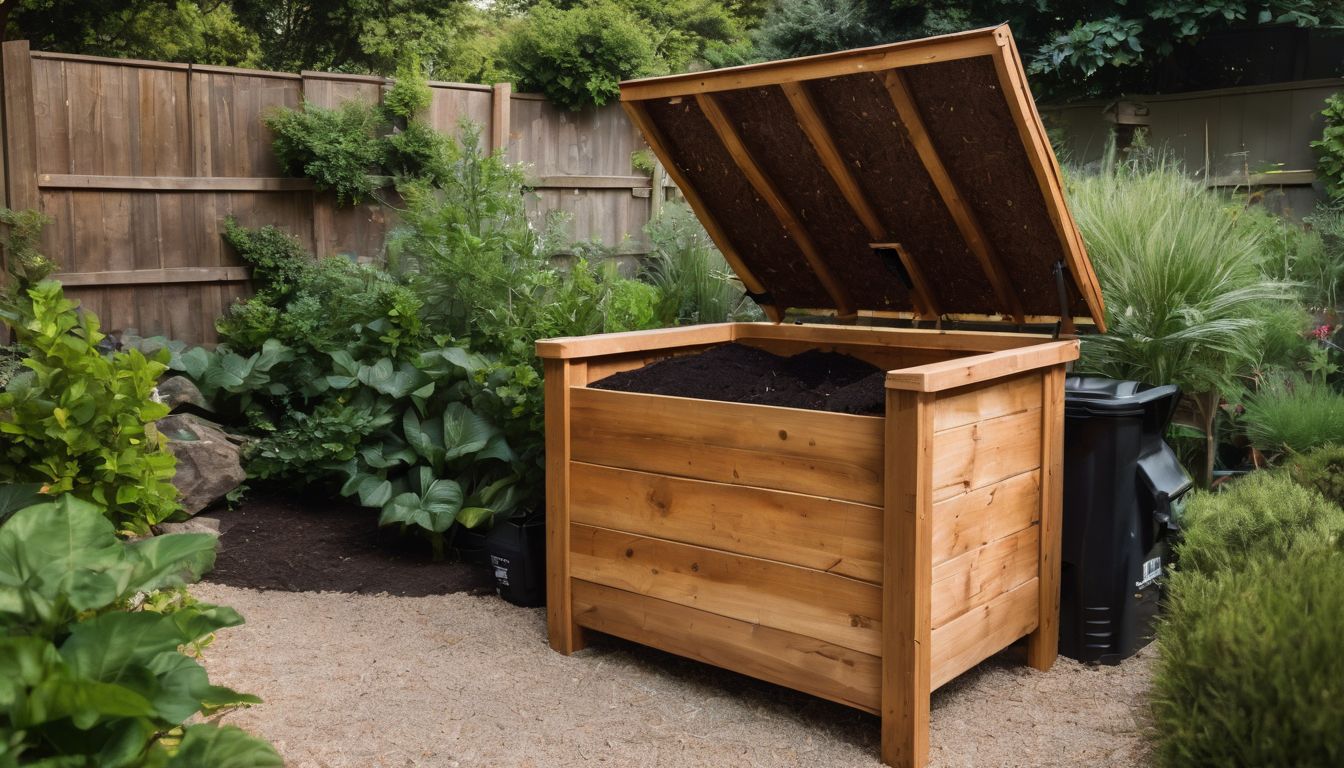If your compost pile isn’t breaking down as expected, you’re not alone. Each year, countless gardening enthusiasts face similar challenges with their compost heaps. Our guide offers practical tips and straightforward solutions to keep your compost healthy and productive.
Let’s solve these composting conundrums together!
Key Takeaways
- Moisture balance is essential in composting; too wet leads to slime and odour, while too dry slows decomposition. Adjust by adding dry material or water as needed.
- Temperature control is important; a compost thermometer helps maintain 110-160°F for effective breakdown and pathogen destruction.
- Regularly turning the pile promotes oxygen flow, aiding microorganisms in efficient decomposition and preventing odours.
- Pests can be deterred by burying food scraps deeply within the pile and avoiding meat or dairy which attract rodents and flies.
- Using proper ratios of green (nitrogen-rich) to brown (carbon-rich) materials ensures a healthy, odour-free compost environment.
Common Problems in Composting
– Moisture levels can either be too wet or too dry, affecting the decomposition process. Pests, temperature fluctuations, and difficulties in turning the compost pile are also common issues that composters face.
Moisture (too wet or too dry)
Getting the moisture balance right is crucial for successful composting. If your pile becomes too wet, it can turn into a soggy mess that lacks oxygen and starts to smell. Too much water squeezes air out of the spaces between compost materials, slowing down decomposition and making it slimy.
On the flip side, a pile that’s too dry won’t properly break down because microorganisms need water to do their work.
To fix a compost heap that’s overly damp, add dry brown materials like leaves or straw to soak up excess liquid. This will also help reintroduce air back into the mix. For a too-dry pile, sprinkle water evenly over it to achieve a consistent level of dampness like that of a wrung-out sponge.
Regular turning helps distribute moisture and maintains proper aeration, which combats both extremes efficiently.
Pests
Pests can be a common challenge when composting. Insects like flies and ants are attracted to food scraps in the compost pile, while rodents may also find their way into outdoor compost bins.
To deter pests, ensure that your compost materials are buried under at least 10 inches of other organic matter, and regularly turn the pile to discourage infestations. Additionally, avoid adding meat or dairy products to the compost as these can attract unwanted critters.
Ensuring your compost pile is free from pests not only prevents potential nuisances but also contributes to a healthier and more effective decomposition process. By taking proactive steps to manage pests, you’ll maintain an optimal environment for successful composting.
Temperature
After addressing the issue of pests in your compost, it’s important to shift your focus to temperature. Monitoring the temperature of your compost pile is crucial for its success. Ensure that the internal temperature reaches between 135°F and 160°F.
This heat helps kill weed seeds, pathogens, and unwanted insects while accelerating decomposition.
To maintain an ideal temperature, turn the compost regularly and monitor using a compost thermometer. Adjust moisture levels by adding water or dry materials as needed to regulate heat production.
Grass clippings
To maintain the heat in your compost pile and aid in the decomposition process, consider adding grass clippings. Grass clippings are rich in nitrogen, which is essential for speeding up the breakdown of organic materials.
Ensure that you mix them well with carbon-rich materials like leaves or shredded paper to strike a good balance and prevent unpleasant odors from forming. Regularly turning the compost will help distribute the grass clippings evenly and ensure they break down efficiently.
To resolve common difficulties with composting, addressing problems related to grass clippings can significantly impact your compost pile’s overall success.
Odors
Composting can sometimes lead to unpleasant odours, which may deter you from the process. To address smelly compost bins, ensure that you are using proper ratios of brown and green materials.
Adding too much food waste or grass clippings without enough dry leaves or paper can cause a foul smell. Incorporate aeration by turning the pile regularly to allow oxygen in and prevent anaerobic conditions, which contribute to bad odours.
Additionally, cover the compost with a layer of finished compost or soil to help contain any smells.
Slimy ingredients and excessive moisture in your compost pile can also lead to unpleasant odours. Balance the moisture levels by adding dry materials such as straw, shredded paper, or wood chips if your compost is too wet.
Turning difficulties
To address turning difficulties, it is essential to regularly aerate the compost pile. Use a pitchfork or shovel to turn the materials every one to two weeks. This helps mix the layers and ensures that oxygen reaches all parts of the pile, promoting efficient decomposition.
Therefore, regular turning prevents compacting and encourages microorganism activity which can help solve issues related to moisture balance and temperature regulation within the compost pile.
In addition to aiding in breaking down materials, frequent turning also helps distribute moisture evenly throughout the pile, preventing soggy spots and promoting aeration for an effective breakdown of organic matter.
Solutions to Common Composting Problems
To address common composting problems, ensure proper aeration by turning the pile regularly and balancing moisture levels. Adding nitrogen-rich materials and using a compost bin or tumbler can also help resolve issues with pests, odors, and temperature fluctuations.
Proper aeration
To address this issue, ensure that your compost pile receives proper aeration. This can be done by turning the materials regularly to allow for oxygen flow throughout the compost. Oxygen plays a crucial role in supporting the microorganisms responsible for breaking down organic matter into nutrient-rich compost, so ensuring adequate aeration is vital in maintaining an efficient and effective composting process.
By incorporating this practice, you can successfully overcome common obstacles such as heat buildup, soggy compost, and issues with slimy ingredients.
Furthermore, employing proper aeration helps in resolving rotting and temperature challenges within your compost pile. Regular turning allows for airflow to reach all parts of the heap, aiding in achieving optimal decomposition while preventing unpleasant odours from developing.
Balancing moisture levels
To keep your compost pile healthy, it’s important to balance moisture levels. If the pile is too dry, add water gradually until it reaches a damp consistency. On the other hand, if it’s too wet, mix in some dry materials like leaves or sawdust to absorb excess moisture.
Monitoring and adjusting the moisture level regularly will create an environment where beneficial organisms can thrive and break down organic matter efficiently.
Maintaining balanced moisture levels in your compost pile is crucial for successful decomposition. By using the right amount of water and keeping an eye on the overall dampness, you’ll create optimal conditions for beneficial microorganisms to do their work effectively without causing any unnecessary odors or issues with pests.
Adding nitrogen-rich materials
After balancing the moisture levels in your compost pile, the next step is to introduce nitrogen-rich materials. This type of material includes green waste like grass clippings, vegetable scraps, and coffee grounds.
Nitrogen helps the microorganisms break down the organic matter quickly and efficiently, heating up your compost pile. By adding these nitrogen-rich materials regularly, you can maintain a healthy balance between carbon and nitrogen which is essential for successful decomposition.
To supercharge your composting process, ensure that you layer brown materials with green ones, aiming for roughly one-third green to two-thirds brown by volume. Keeping this ratio in mind will help prevent odors while providing essential nutrients for beneficial bacteria‘s growth and activity within the compost pile.
Using a compost bin or tumbler
Utilise a compost bin or tumbler to accelerate the composting process. Add kitchen scraps, yard waste, and organic materials into the bin or tumbler regularly. Turn the contents every few days to aerate and mix them.
The enclosed space of the bin or tumbler helps regulate temperature and moisture levels, preventing pest infestations and odour issues.
A compost bin or tumbler provides a contained environment for decomposition, reducing the likelihood of attracting pests or producing unpleasant odours. The controlled conditions also ensure consistent heat levels necessary for efficient composting.
Avoiding certain materials
Avoid using grease, oils, dairy products, or meat scraps in your compost pile as they can attract pests and create unpleasant odors. It’s best to steer clear of plants treated with pesticides or herbicides – these chemicals could inhibit decomposition and harm the beneficial microorganisms in your compost.
Also, avoid adding weeds that have gone to seed, as this could lead to unwanted weed growth when you use the finished compost.
By avoiding these materials and being mindful of what you add to your compost pile, you can help ensure a healthy environment for decomposition and produce nutrient-rich compost for your garden without any unnecessary challenges.
Turning the pile regularly
To ensure that your compost pile remains healthy and active, it’s essential to turn it regularly. This process helps aerate the pile, allowing oxygen to reach the microorganisms responsible for breaking down materials.
Turning also aids in distributing moisture evenly throughout the pile, preventing any areas from becoming too wet or dry. By turning the compost regularly, you’ll speed up decomposition and reduce the likelihood of foul odors developing.
Plus, regular turning ensures that all parts of the compost receive an equal amount of warmth and moisture, promoting a balanced breakdown of organic matter.
How to Keep Your Compost Cooking
Maintain consistent addition of materials, monitor temperature, and use a compost thermometer to ensure your compost stays active – find out more about troubleshooting common composting problems in our blog!
Consistency in adding materials
Consistently adding materials such as kitchen scraps, yard waste, and shredded paper maintains a healthy balance in the compost pile. Layering different types of organic matter regularly provides a steady supply of nutrients for the microorganisms that break down the materials.
This helps in maintaining an optimal environment for decomposition, ensuring that your compost stays active and continues to heat up efficiently.
Regularly incorporating new materials into the compost pile promotes consistent microbial activity, which is key to successful decomposition. Maintaining this consistent supply of ingredients encourages beneficial bacterial growth and accelerates the breakdown process, resulting in nutrient-rich compost for your gardening needs.
Adding water or dry materials as needed
To maintain the ideal moisture levels in your compost pile, it’s important to regularly check and adjust as needed. If the pile is too dry, sprinkle it with water using a watering can or hose with a mist setting.
Ensure that the moisture is evenly distributed by turning the compost to incorporate the added water. On the other hand, if your compost becomes too wet, mix in dry materials such as straw, shredded paper, or dried leaves to help absorb excess moisture.
Keeping an eye on this balance will promote an optimal environment for decomposition.
Balancing moisture levels is crucial for ensuring effective decomposition and preventing unpleasant odors. The right amount of water helps microorganisms break down organic matter efficiently while maintaining airflow within the pile.
Monitoring temperature
To keep your compost pile working efficiently, it is essential to monitor the temperature regularly. Using a compost thermometer allows you to check that the temperature remains within the optimal range for decomposition, which is between 110 and 160 degrees Fahrenheit.
Regularly turning the pile also helps distribute heat evenly, ensuring all materials are breaking down effectively.
Consistently monitoring and maintaining an ideal composting temperature supports the breakdown of organic matter and accelerates nutrient-rich compost production. By keeping an eye on the temperature and making any necessary adjustments, you can ensure that your compost pile remains productive and effective in creating valuable soil amendments for your garden.
Using a compost thermometer
To ensure that your compost pile is working optimally, it’s essential to monitor the temperature regularly. This can be easily achieved by using a compost thermometer. Insert the thermometer into different parts of the pile to get an accurate reading of the internal temperature.
It should ideally range between 110 and 160 degrees Fahrenheit for efficient decomposition. By keeping track of the temperature, you can make adjustments as needed, such as turning the pile or adding more materials to maintain an optimal environment for bacteria and other microorganisms to break down organic matter effectively.
Additionally, using a compost thermometer allows you to identify potential issues early on, such as if the temperature is too low, indicating that more nitrogen-rich materials are needed, or if it’s too high, suggesting excessive moisture or lack of proper aeration.
Turning the pile
To maintain a healthy compost pile, turning it regularly is essential. This helps to aerate the materials, ensuring that oxygen reaches all parts of the pile and speeding up decomposition.
Turning also prevents odors by allowing excess moisture to evaporate and regulates temperature for optimal microbial activity. Use a pitchfork or shovel to turn the pile every one to two weeks, mixing the outer layers into the center and vice versa.
The process should be thorough but gentle, avoiding compacting the materials.
To ensure proper aeration and decomposition in your compost pile, regular turning is crucial. By aerating the materials through turning, you can prevent issues such as foul odors and slow decomposition while promoting beneficial microorganisms’ growth.
Using Compost
Using compost has numerous benefits for plants, such as enhancing soil fertility and structure, so learn more about the advantages of using compost in your gardening practices.
Benefits for plants
Compost benefits plants by improving soil structure, promoting root growth, and enhancing nutrient availability. As a natural fertiliser, it provides essential nutrients like nitrogen, phosphorus, and potassium to support healthy plant development.
Using compost as a soil amendment increases soil organic matter, which helps retain moisture and reduces the need for chemical fertilisers. This results in stronger, more resilient plants that are better equipped to resist diseases and pests.
Incorporating compost also enhances the microbial activity in the soil, supporting a diverse community of beneficial organisms vital for plant health. By enriching the soil with organic matter from compost, it encourages earthworms and other beneficial microorganisms that aid in breaking down nutrients for plant uptake.
Using compost as a soil amendment
To maximise the benefits of compost, consider using it as a soil amendment. Mixing compost into your garden soil can enhance its structure, moisture retention, and nutrient content.
This enriches the soil with organic matter, improving its overall health and fertility. The addition of compost also helps to create a healthy environment for beneficial microorganisms that aid in plant growth.
Moreover, using compost as a soil amendment reduces the need for chemical fertilisers and enhances the natural ecosystem in your garden.
Topdressing with compost
Using compost as a topdressing for your garden or lawn provides vital nutrients and improves soil structure. Spread a thin layer of compost over the surface, then gently rake it in to cover the area.
This helps retain moisture and suppresses weed growth, promoting healthy plant growth while reducing the need for chemical fertilisers.
Topdressing with compost enriches the soil, encourages beneficial microbial activity, and enhances its ability to retain water – all essential for maintaining healthy plants and ecosystems.
Conclusion
In conclusion, troubleshooting common composting problems involves addressing issues such as moisture levels, pests, and temperature. Ensuring proper aeration, balancing moisture levels, and turning the pile regularly are key solutions.
Maintaining consistency in adding materials and monitoring temperature will help keep your compost cooking effectively. Using compost can provide numerous benefits for plants and improve soil quality for a greener environment.
FAQs
1. What should I do if my compost heap is too wet?
To overcome a wet compost heap, add more brown materials like dry leaves or cardboard to absorb the excess moisture.
2. How can I fix a compost heap that’s not heating up?
Kickstart your compost heap temperature issues by mixing in green materials such as grass clippings or food scraps to activate the decomposition process.
3. Why does my compost have a bad smell and how can I address it?
Bad smells often indicate problems in composting; turn the heap to let air in and check for excess green material, which you can balance out with browns to eliminate odours.
4. My compost isn’t breaking down properly – what troubleshooting steps should I take?
To resolve this common difficulty in composting, chop larger pieces into smaller chunks and ensure there is a good balance of greens and browns while maintaining adequate moisture levels.
5. Can pests become an issue with my home-made fertiliser and how do I deal with them?
Yes, If overcoming these hurdles becomes necessary, keep your bin covered and bury food waste deep within your heap to deter unwelcome creatures.





